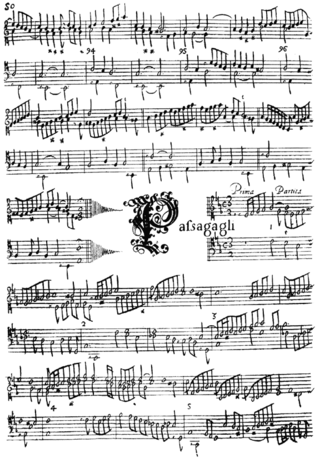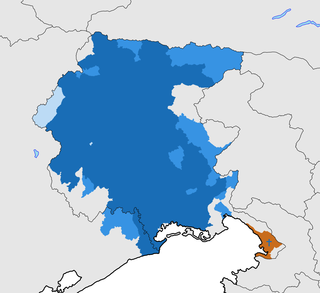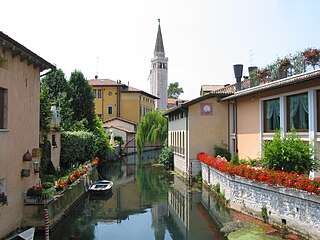Related Research Articles

The passacaglia is a musical form that originated in early seventeenth-century Spain and is still used today by composers. It is usually of a serious character and is typically based on a bass-ostinato and written in triple metre.

A suite, in Western classical music, is an ordered set of instrumental or orchestral/concert band pieces. It originated in the late 14th century as a pairing of dance tunes and grew in scope to comprise up to five dances, sometimes with a prelude, by the early 17th century. The separate movements were often thematically and tonally linked. The term can also be used to refer to similar forms in other musical traditions, such as the Turkish fasıl and the Arab nuubaat.

The rondo is a musical form that contains a principal theme which alternates with one or more contrasting themes, generally called "episodes", but also occasionally referred to as "digressions" or "couplets". Some possible patterns include: ABACA, ABACAB, ABACBA, or ABACABA.

Friuli-Venezia Giulia is one of the 20 regions of Italy and one of five autonomous regions with special statute. The regional capital is Trieste on the Gulf of Trieste, a bay of the Adriatic Sea.

Friuli is a historical region of northeast Italy. The region is marked by its separate regional and ethnic identity predominantly tied to the Friulians, who traditionally spoke the Friulian language. It comprises the major part of the autonomous region Friuli-Venezia Giulia, i.e. the administrative provinces of Udine, Pordenone, and Gorizia, excluding Trieste.

Friulian or Friulan is a Romance language belonging to the Rhaeto-Romance family, spoken in the Friuli region of northeastern Italy. Friulian has around 600,000 speakers, the vast majority of whom also speak Italian. It is sometimes called Eastern Ladin since it shares the same roots as Ladin, but over the centuries, it has diverged under the influence of surrounding languages, including German, Italian, Venetian, and Slovene. Documents in Friulian are attested from the 11th century and poetry and literature date as far back as 1300. By the 20th century, there was a revival of interest in the language.

Le Tombeau de Couperin is a suite for solo piano by Maurice Ravel, composed between 1914 and 1917. The piece is in six movements, based on those of a traditional Baroque suite. Each movement is dedicated to the memory of a friend of the composer who had died fighting in World War I. Ravel also produced an orchestral version of the work in 1919, although this omitted two of the original movements.

Ma mère l'Oye is a suite by French composer Maurice Ravel. The piece was originally written as a five-movement piano duet in 1910. In 1911, Ravel orchestrated the work.

The Julian March, also called Julian Venetia, is an area of southern Central Europe which is currently divided among Croatia, Italy, and Slovenia. The term was coined in 1863 by the Italian linguist Graziadio Isaia Ascoli, a native of the area, to demonstrate that the Austrian Littoral, Veneto, Friuli, and Trentino shared a common Italian linguistic identity. Ascoli emphasized the Augustan partition of Roman Italy at the beginning of the Empire, when Venetia et Histria was Regio X.

The flag of Friuli is the official standard of historical Friuli. A Friuli-Venezia Giulia Autonomous Regional law describes the flag as consisting of "…a rectangular standard featuring at its centre a golden heraldic eagle with outspread wings, headturned to the left, open beak and red claws, set in a sky blue field. The crest covers three fifths of the height of the flag, which in turn is two thirds of its length."

Sacile is a comune (municipality) in the Regional decentralization entity of Pordenone, in the Italian region of Friuli-Venezia Giulia. It is known as the "Garden of the Serenissima" after the many palaces that were constructed along the river Livenza for the nobility of the Most Serene Republic of Venice.
The musical fortunes of Friuli-Venezia Giulia are closely tied to its political fortunes over the course of centuries, all having to do with proximity to the great maritime Republic of Venice as well as to the Austro-Hungarian empire and the vicissitudes of being a heavily contested area during the first World War. The vast comings and goings of various ethnic groups through this section of Italy have led to cultural and musical variety for diversity.

Friulianliterature is the literature of the autonomous Italian region of Friuli, written in the local Friulian language.
Italian music terminology consists of words and phrases used in the discussion of the music of Italy. Some Italian music terms are derived from the common Italian language. Others come from Spanish, or Neapolitan, Sicilian, Sardinian or other regional languages of Italy. The terms listed here describe a genre, song form, dance, instrument, style, quality of music, technique or other important aspect of Italian music.

The Friuli Movement is a regionalist political party in Friuli, Italy.

Friulians, also called Friulans or Furlans, are an ethnolinguistic minority living primarily in Italy, with a significant diaspora community.

Furlane or friulanes, also known as Gondolier slippers, are Venetian shoe slippers. Characterized by their flexible rubber soles, these shoes are usually flats or low heels, with velvet fabric uppers.

The composition in the Friulian language entitled Incuintri al doman, written by Renato Stroili Gurisatti and set to music by maestro Valter Sivilotti in 2017, is the official anthem of Friuli.

Alfeo Mizzau was an Italian politician and author. A business consultant by trade, in 1945 he joined the Christian Democrats, remaining part of it for decades, in which he dedicated himself to intense political activity. He was a member of the European Parliament from 1984 to 1989.
References
- Heartz, Daniel. 1999. "A Venetian Dancing Master Teaches the Forlana: Lambranzi's Balli teatrali". Journal of Musicology 17, no. 1 (Winter):136–51.
- Little, Meredith Ellis. 2001. "Forlana [furlana]". The New Grove Dictionary of Music and Musicians, second edition, edited by Stanley Sadie and John Tyrrell. London: Macmillan Publishers.
- Maniacco, Tito. 2002. Storia del Friuli: il lavoro dei campi, la tradizione gastronomica, le radici della cultura contadina, le rivolte, il dramma dell'emigrazione e la nascita dell'identità di una regione. Tradizioni italiane 17. Rome: Newton & Compton Editori. ISBN 88-8289-706-0.
- ↑ Maniacco 2002, p. 56.
- 1 2 Little 2001.
- ↑ Heartz 1999, pp. 145–6.
- ↑ Musedita, 2005